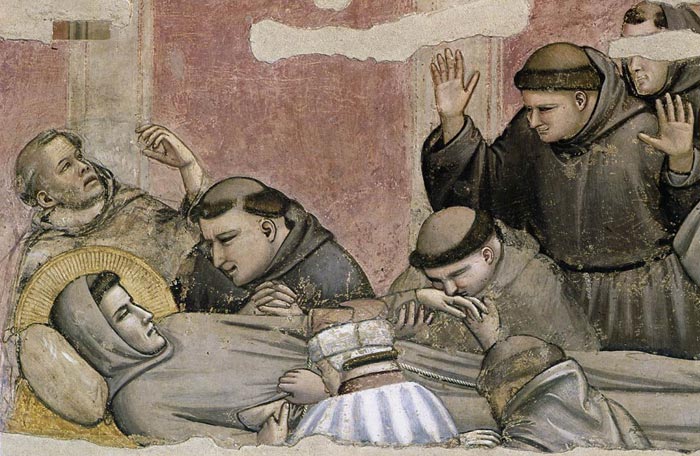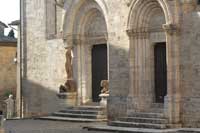| |
|
| The Basilica di Santa Croce is the principal Franciscan church in Florence. It is situated on the Piazza di Santa Croce. The site, when first chosen, was in marshland outside the city walls. Legend says that Santa Croce was founded by St Francis himself. It is the burial place of some of the most illustrious Italians, such as Michelangelo, Galileo, Machiavelli, Foscolo, Gentile and Rossini.
Its most notable features are its sixteen chapels, many of them decorated with frescoes by Giotto and his pupils, and its tombs and cenotaphs.
According to Lorenzo Ghiberti, Giotto painted chapels for four different Florentine families in the church of Santa Croce, although he does not identify which chapels they were. It is only with Vasari that the four chapels are identified: the Bardi Chapel (Life of St. Francis), the Peruzzi Chapel (Life of St. John the Baptist and St. John the Evangelist, perhaps including a polyptych of Madonna with Saints now in the Museum of Art of Raleigh, North Carolina) and the lost Giugni Chapel (Stories of the Apostles) and the Tosinghi Spinelli Chapel (Stories of the Holy Virgin). As with almost everything in Giotto's career, the dates of the fresco decorations that survive in Santa Croce are disputed. The Bardi Chapel, immediately to the right of the main chapel of the church, was painted in true fresco, and to some scholars the simplicity of its settings seems relatively close to those of Padua, while the Peruzzi Chapel's more complex settings suggest a later date. The Peruzzi Chapel is adjacent to the Bardi Chapel and was largely painted a secco. This technique, quicker but less durable than true fresco, has resulted in a fresco decoration that survives in a seriously deteriorated condition. Scholars who date this cycle earlier in Giotto's career see the growing interest in architectural expansion that it displays as close to the developments of the giottesque frescoes in the Lower Church at Assisi, while the Bardi frescoes have a new softness of color that indicates the artist going in a different direction, probably under the influence of Sienese art, and so must be a later development.
|
The Peruzzi Chapel pairs 3 frescoes from the life of St. John the Baptist (The Annunciation of John's Birth to his father Zacharias; The Birth and Naming of John; The Feast of Herod) on the left wall with 3 scenes from the life of St. John the Evangelist (The Visions of John on Ephesus; The Raising of Drusiana; The Ascension of John) on the right wall. The choice of scenes has been related to both the patrons and the Franciscans. Because of the serious condition of the frescoes, it is difficult to discuss Giotto's style in the chapel, although the frescoes show signs of his typical interest in controlled naturalism and psychological penetration. The Peruzzi Chapel was especially renowned during Renaissance times. Giotto's compositions influenced Masaccio's Cappella Brancacci, and Michelangelo is known to have studied the frescoes.
Giotto's paintings in the lance-shaped chapel are believed to have had a major influence on Michelangelo, who was born nearly 140 years after Giotto died and who painted the Sistine Chapel in the early 1500s.
The Bardi Chapel is of particular interest as it depicts the life of St. Francis, following a similar iconography to the frescoes in the Upper Church at Assisi, dating from 20–30 years earlier. A comparison makes apparent the greater attention given by Giotto to expression in the human figures and the simpler, better-integrated architectural forms. Giotto represents only 7 scenes from the saint's life here, and the narrative is arranged somewhat unusually. The story starts on the upper left wall with St. Francis Renounces his Father. It continues across the chapel to the upper right wall with the Approval of the Franciscan Rule, moves down the right wall to the Trial by Fire, across the chapel again to the left wall for the Appearance at Arles, down the left wall to the Death of St. Francis, and across once more to the posthumous Visions of Fra Agostino and the Bishop of Assisi. The Stigmatization of St. Francis, which chronologically belongs between the Appearance at Arles and the Death, is located outside the chapel, above the entrance arch. This arrangement encourages viewers to link scenes together: to pair frescoes across the chapel space or relate triads of frescoes along each wall. These linkings suggest meaningful symbolic relationships between different events in St. Francis's life.
|
|
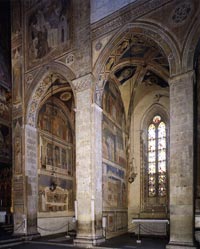 The Bardi Chapel and the Peruzzi Chapel The Bardi Chapel and the Peruzzi Chapel
in Santa Croce, Florence |
|
|
|
| |
|
Frescoes in the Peruzzi Chapel
Scenes from the Life of St John the Baptist
|
|
|
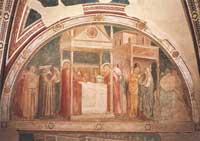 |
|
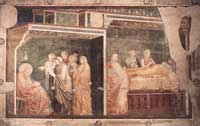 |
|
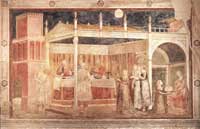 |
Annunciation to Zacharias |
|
Birth and Naming of the Baptist |
|
Feast of Herod |
| |
|
|
|
|
Scenes from the Life of St John the Evangelist
|
|
|
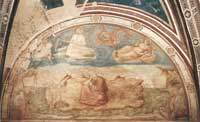 |
|
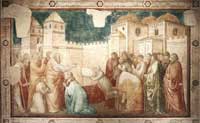 |
|
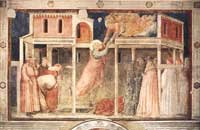 |
St John on Patmos |
|
Raising of Drusiana |
|
Ascension of the Evangelist |
| |
|
|
|
|
|
| |
|
|
Frescoes in the Bardi Chapel
|
|
|
Giotto also received the commission for the second surviving chapel in the Franciscan church of Santa Croce in Florence from a banker. The donor Ridolfo de' Bardi and his brother jointly inherited their father's banking house and commercial interests. This involved maintaining a good relationship with the powers who determined the politics of the day - with the pope, with the Neapolitan ruling house of Anjou, and with the Guelph party. He was able to go on cultivating this highly effective mixture of faith, politics and money for the next three decades until his house went bankrupt in the 1340s.
The Bardi family chapel is situated to the right of the choir, which means that it is the first chapel of the southern transept, and dedicated to St. Francis. As was the case with the neighboring Peruzzi Chapel, these frescoes were also painted over in the 18th century, rediscovered in the 19th century, and reworked. During their restoration in the middle of our own century, all reworked areas were removed and the ruined parts sealed with plaster. For this reason, some of the frescoes have empty spaces, although the actual painting is considerably better preserved here than in the Peruzzi Chapel, since Giotto went back to working with fresh plaster here.
As in the Peruzzi chapel, three frescoes framed by ornamental bands decorate each wall. But unlike in the former, these are dedicated to just the one saint, St. Francis. The Renunciation of Worldly Goods and the Confirmation of the Rule are situated in the lunettes. In the middle register the Apparition at Arles and the Trial by Fire before the Sultan are depicted. The Death of St. Francis and Inspection of the Stigmata and the Apparition at Aries can be seen at eye level. Above the entrance to the chapel the Stigmatisation is portrayed, as it were, as a summation of the life of the saint. The seraphim from whom Francis receives the stigmata here appears — unlike at Assisi or in the panel in the Musée du Louvre — as the crucified Christ.
While the St Francis in the paintings in the Upper Church at Assisi wears a beard, Giotto depicts him without one here, as in the vault frescoes in the Lower Church. This manifestation of the saint, favoured by the order since 1316, must have been particularly agreeable to a banker, since it no longer expressed the original significance of personal poverty.
Unlike the Peruzzi Chapel, the construction of the architecture portrayed in the frescoes is here based on a viewpoint within the chapel. The perspective of the architectural structures in the paintings changes with great logical consistency — the higher the register, the greater the foreshortening from below. This only increases the impression of fluidity between real and painted space.
|
Scenes from the Life of Saint Francis
|
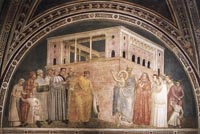 |
|
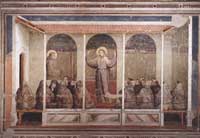 |
|
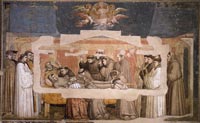 |
Renunciation of Wordly Goods |
|
Apparition at Arles |
|
Death and Ascension of St Francis |
| |
|
|
|
|
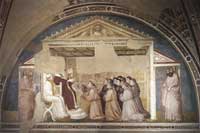 |
|
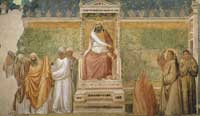 |
|
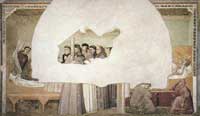 |
Confirmation of the Rule |
|
Ascension of the Evangelist |
|
Vision of the Ascension of St Francis |
| |
|
|
|
|
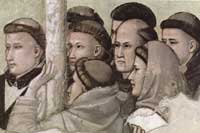 |
|
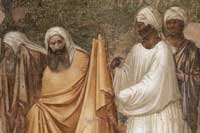 |
|
|
Vision of the Ascension of St Francis (detail) |
|
Vision of the Ascension of St Francis (detail) |
|
|
|
|
|
Art in Tuscany | Giotto di Bondone | The Bardi Chapel in Santa Croce, Florence |
|
|
| |
|
|
|
|
| |
|

Churches in Florernce |
The Basilica di Santa Croce
Art in Tuscany | Italian Renaissance painting

[1] The Italian painter, sculptor and architect Giotto di Bondone (known simply as Giotto) was active during the proto-Renaissance era in Padua and Florence. Best known for his humanistic religious frescoes, Giotto - along with the Sienese artist Duccio di Buoninsegna (1255-1319) and Cimabue (1240-1302) - was a key figure in the pre-Renaissance period and is considered one of the founders of fine art painting in Europe. His pictures broke away from the symbolism of Byzantine art and introduced a new naturalism and realism into painting. Although much of his work has been destroyed, his most notable feat was the cycle of fresco paintings in the Cappella degli Scrovegni in Padua (Arena Chapel) (1304-13). Other major works include his frescoes on the life of Saint Francis at Assisi, and in the Bardi and Peruzzi Chapels (created after 1320) in the Franciscan church Santa Croce in Florence.
Many of the details of Giotto's life are sketchy and open to controversy, including the date and place of his birth. It is believed that he was born around 1267 in a village called Vespignano, near Florence. His father was a small landowner described as 'a person of good standing' in public records from the time.
Legend has it, the young Giotto was discovered by the renowned Italian painter Cimabue (also known as Benvenuto di Giuseppe) while he was drawing pictures of his father's sheep. Apparently Cimbaue was so impressed he asked the boy's father if he could take him to Florence as an apprentice. However, it is far more probable that Giotto's family were well off enough to move to Florence and send the 12 year old Giotto to Cimbue's studio as an apprentice.
Around a year later Giotto followed Cimabue to Rome where he was introduced to a school of fresco painters, including the famous Pietro Cavallini and the well-known Florentine architect and sculptor Arnolfo di Cambio.
The earliest of Giotto's known works, is believed to be a series of frescos painted on a church at Assisi about the life of St Francis. At a time when realism in art was not yet popular, these frescos were refreshingly realistic and the figures very natural looking. There is some dispute as to whether it is in fact the hand of Giotto, and recent documents have come to light to suggest that the fresco is in fact the work of a group of unnamed proto-Renaissance artists. If this is so, then Giotto's next most celebrated work, the Fresco of Padua, owes much to the naturalism of these painters.
The Scrovegni Chapel in Padua | In about 1305 Giotto painted a series of 38 frescos at the Scrovegni (Arena) Chapel in Padua. The frescos illustrate the life of Jesus Christ and the Virgin Mary, and the figures are emotionally expressive and realistic looking. Although Giotto specialized in religious art, he broke from the traditions of Byzantine art (which valued the symbolic approach over realism) by infusing his figure drawing with real-life people, poses and expressions. He also introduced an early form of linear perspective into his painting. Although other artists like Pietro Cavallini had started working in this style, Giotto took it much further and set a new standard for figure painting. The art historian and writer Giorgio Vasari, a biographer of Giotto, wrote many stories about the latter's mastery of drawing. One story told how Pope Boniface VIII sent a messenger to Giotto to request samples of his work. As a response, Giotto dipped his brush into red paint and in one continuous stroke painted a perfect circle. He told the messenger to take the circle back to the Pope and that it's worth would be recognised. When the pope received the circle, according to Vasari, he 'instantly perceived that Giotto surpassed all other painters of his time'.
Giotto's reputation as a painter quickly grew, as did his commissions. By 1301 documents show he owned several large estates in Florence (apparently he was a good saver!) and that his workshop had become a leading studio in Italy. But in spite of his fame and demand for his services, no painting survives to this day that is documented by him. There is a certain measure of agreement that Giotto painted frescos at four chapels at the Sta Croce in Florence and the Bardi Chapel. Some of the frescos are in bad condition, as they were whitewashed in the 18th century, but despite this, remain impressive to this day. Several panel paintings on the Stefaneschi Altarpiece at the Vatican bear Giotto's signature, but it believed that this is just a trademark confirming it came from his workshop, rather than a signature of his personal work. On the other hand, the Ognissanti Madonna, c.1315 (Uffizi Gallery) is not signed, but the work is such a grandiose spectacular that it is universally accepted as Giotto's.
Sometime between 1303 and 1310 Giotto executed his most influential work, the painting of a series of 37 scenes at the Scrovegni Chapel in Padua. Famous panels in the series include The Adoration of the Magi, in which a comet-like Star of Bethlehem streaks across the sky, and the Flight from Egypt. The 19th century English critic John Ruskin said of Giotto's realism 'He painted the Madonna and St. Joseph and the Christ, yes, by all means ... but essentially Mamma, Papa and Baby'. In 1311 Giotto returned to Florence where he executed a work of mosaic art for the facade of the old St. Peter's Basilica and now lost except for some fragments. Remaining frescos from his later years show that Giotto's style had become more ornate, which perhaps reflected the new International Gothic style, which was emerging in Europe.
Revered by this time - even by the more conservative Sienese School of painting - as one of the great new innovative artists, Giotto was honored with the title of Magnus Magister (Great Master) in 1334 by the city of Florence and was appointed city architect and superintendent of public works. During this time he designed the famous campanile (bell tower) on St Peters Square, but died before the work was completed. He last known completed work is the decoration of Podestà Chapel in the Bargello, Florence.
Giotto died in January 1337, but there is some controversy over the exact location of his grave. In 1970, bones were discovered underneath the paving of the Church of Santa Reparta (where his biographer claims he was buried). Forensic examination confirms that they were the bones of a painter (a range of chemicals including arsenic and lead, both commonly found in paint, were discovered in the bones). The front teeth were worn in such as way as to be consistent with holding a brush between the teeth. A reconstruction of the skeleton shows a man with a very large head, large crooked nose and one eye more prominent than the other. The bones were of a small man, only about 4 foot tall who suffered from a form of dwarfism. This would be consistent with a picture in one of the frescos at the church of Santa Croce of a dwarf-like figure which is supposed to be a self portrait of Giotto. His biographer, who was a friend of Giotto, says 'there was no uglier man in the city of Florence'. The body was reburied with honour near the grave of the Renaissance architect Filippo Brunelleschi.
Although Giotto lacked technical knowledge of anatomy and perspective that painters in futures year were to learn, he had grasped something far more important. He grasped human emotion, and was able to portray this is a powerful and meaningful way. He managed to convey, stress, soul-searching, grief and joy through his paint brush, and it was this gift he passed onto future masters of Renaissance art such as Mantegna, Botticelli, Michelangelo, Raphael, Leonardo Da Vinci, Giusto de'Menabuoi, Jacopo Avanzi, Titian and Altichiero. Italian painter Cennino Cennini wrote in about 1400 that `Giotto translated the art of painting from Greek to Latin.'
[2] The Cambridge companion to Giotto, Giotto, By Anne Derbes, Mark Sandona.
Basilica of Santa Croce, Florence
|
The restoration site in Santa Croce
The much-awaited guided tours of the restoration site of the frescoes in Santa Croce, the great Florentine basilica of the Holy Cross, have finally begun. The eight frescoes on the side walls of the Cappella Maggiore, painted in 1380 by Agnolo Gaddi and depicting the Legend of the True Cross, are now being restored. This is a unique opportunity to come face-to-face with the works of this great artist influenced by Giotto. The tour of the restoration site includes gradual ascension up 7 levels, for a total of 90 steps. There are three stops for explanations of the works. For safety reasons, access is only allowed to children over 12.
The tours, which last approximately 40 minutes, start on 16th May. The guided groups will include a maximum of 15 visitors. Booking required. Timetable of guided tours: from Monday to Friday at 10 am - 11 am - 12 noon - 2 pm - 3 pm - 4 pm.
The ticket costs € 13.00 and also allows entrance to the Basilica, the cloisters and the museum. Reservations can be made by phone from 10 am to 2 pm (tel. +39 055 2466105 - dial 3) or else by e-mail booking@santacroceopera.it , specifying the date and time of the visit, the number of people, a cell-phone number to contact, the names and dates of birth of the participants.
(From Apt - Agenzia per il Turismo di Firenze (Florence Official Tourist Office)
|
The Basilica di Santa Croce (Basilica of the Holy Cross) is the principal Franciscan church in Florence, Italy, and a minor basilica of the Roman Catholic Church. It is situated on the Piazza di Santa Croce, about 800 metres south east of the Duomo. The site, when first chosen, was in marshland outside the city walls. It is the burial place of some of the most illustrious Italians, such as Michelangelo, Galileo, Machiavelli, Foscolo, Gentile and Rossini, thus it is known also as the Temple of the Italian Glories (Tempio dell'Itale Glorie).
In 1966, the Arno River flooded much of Florence, including Santa Croce. The water entered the church bringing mud, pollution and heating oil. The damage to buildings and art treasures was severe, taking several decades to repair.
Santa Croce was the first populated area to be overflowed by the flood. This area remained under the water longer compared to the others because it's lower with respect to the river. The Arno river completely filled the Cloister, it penetrated into the crypt, it disrupted the tombs of the Church. The works of removing the mud and the rubble took about two months. But the damages didn't finish here: the Franciscan fathers and those in charge of the Belle Arti saw the most devastating reality: the Crucifix by Cimabue, located in the Museum inside the big Franciscan refectory, was destroyed. Among great difficulties the heavy painted cross, drenched with water, was brought down and laid in a horizontal position. It took six hours to accomplish this difficult task, while the flakes of colour detached and fell in the mud. The mud was sieved and some fragments were recovered.
The statue of Dante, now in front of the church, was still in the middle of the piazza in 1966.
Specific collections affected in Florence were the Archives of the Opera del Duomo (Archivio di Opera del Duomo), 6,000 volumes/documents and 55 illuminated manuscripts were damaged; Gabinetto Vieusseux Library (Biblioteca del Gabinetto Vieusseux): All 250,000 volumes were damaged, namely titles of romantic literature and Risorgimento history; submerged in water, they became swollen and distorted. Pages, separated from their text blocks, were found pressed upon the walls and ceiling of the building; the National Library Centers of Florence (Biblioteca Nazionale Centrale Firenze): Located alongside the Arno River, the National Library was cut off from the rest of the city by the flood. 1,300,000 items (or one-third of their holdings) were damaged, including prints, maps, posters, newspapers and a majority of works in the Palatine and Magliabechi collections.
and the State Archives (Archivio di Stato): Roughly 40% of the collection was damaged, including property and financial records; birth, marriage and death records; judicial and administrative documents; and police records, among others.

|
|
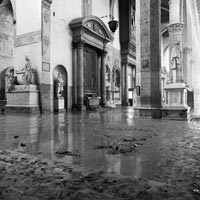 Santa Croce after the Florence Flood, Santa Croce after the Florence Flood,
4th of november 1966
|
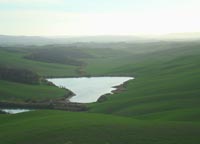 |
|

. |
|
|
Asciano, between Montalcino and Siena |
|
Podere Santa Pia, garden view, December |
|
San Qurico d'Orcia
|

Located in the heart of the Maremma, in southern Tuscany, Podere Santa Pia sits alone on a spectacular, private and tranquil hillside setting with expansive open views of wooded valleys and olive groves. The house itself is an old 'podere' or farmhouse that dates back to the 19th century, now lovingly restored with many of the original details preserved.
Italy and Tuscany are popular not only for their art, their landscapes and their language, but also for their culinary tradition.
The extreme simplicity of Tuscan cuisine is its strongest strength, as the flavours that emerge during the cooking process are vibrant and pure. A little known fact about Tuscan cuisine is that the French learned how to cook from their Tuscan counterparts when it was imported by Catherine de' Medici into the court of Henry II. The Tuscan style of cooking is richly flavoured and wholesome.
Every city in Tuscany had its own regional specialties.
With its original kitchen and the wood burning pizza oven, Podere Santa Pia offers an upbeat atmosphere.
Enjoy an alfresco lunch on the terrace overlooking the spectacular surroudings or fire-up the wood-burning oven and make pizza from scratch.
Holiday accomodation in Tuscany | Podere Santa Pia | Artist and writer's residency
|
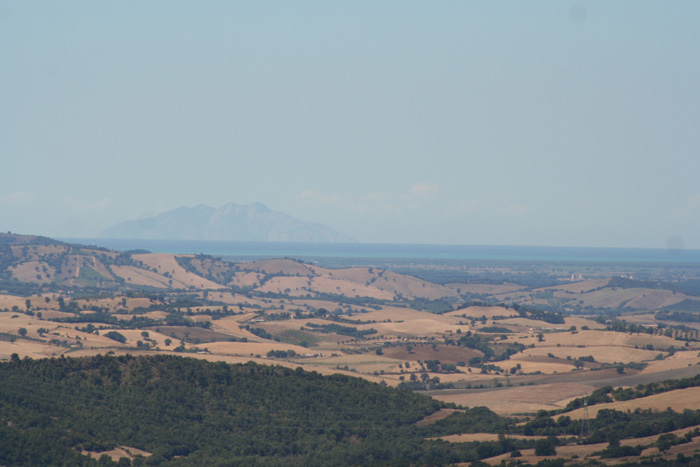 |
|
| |
|
|

. |
|
|
Podere Santa Pia |
|
Podere Santa Pia, garden view, April |
|
View from Podere Santa Pia
on the coast and Corsica |
| |
|
|
| |
|
|
|
|
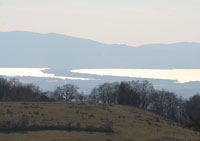 |
|
|
|
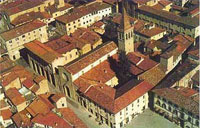
|
Monte Argentario, view from Scansano |
|
|
|
Sansepolcro |
| |
|
|
|
|
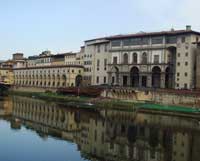
|
|
|
|
|
Vasari Corridor, Florence |
|
Montalcino |
|
Florence, Duomo |
|
|
|
|
|
| |
|
|
|
|
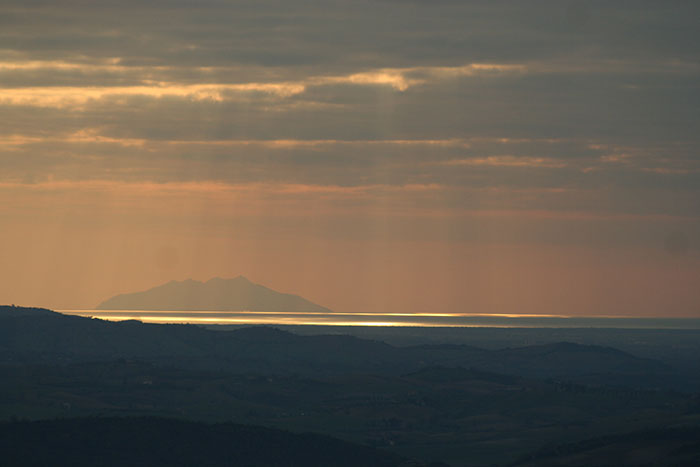 |
Monte Christo. Situated in panoramic position, overlooking vineyards, olive trees and incredible sunsets...
|
| |
|
|
|
|
|
|

